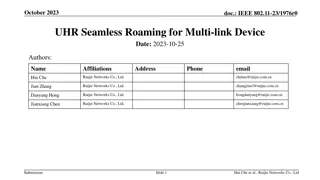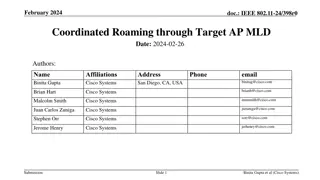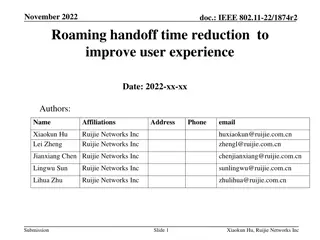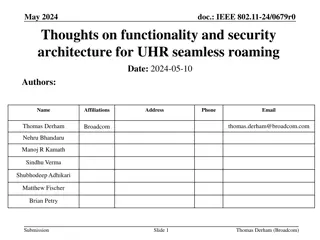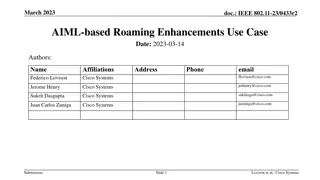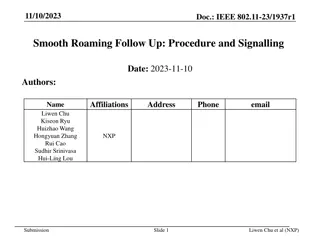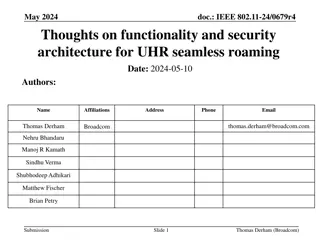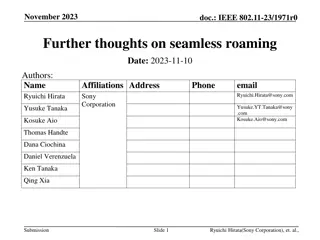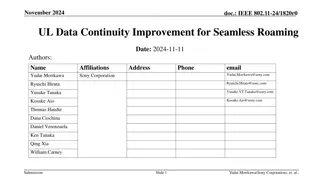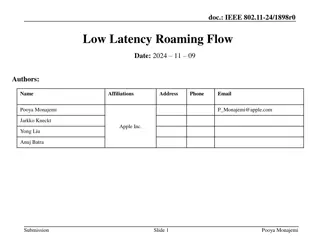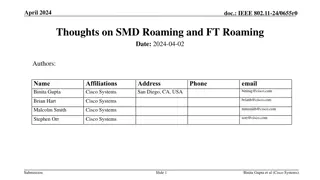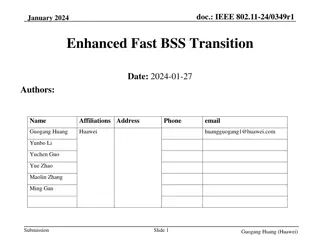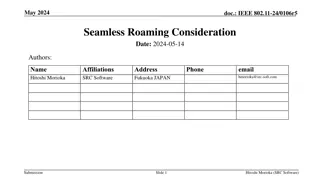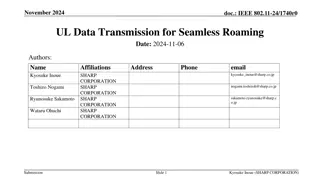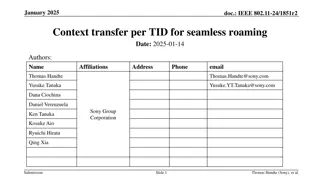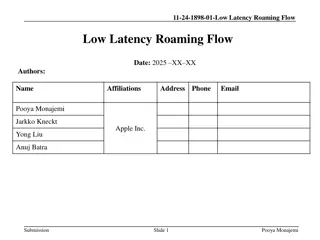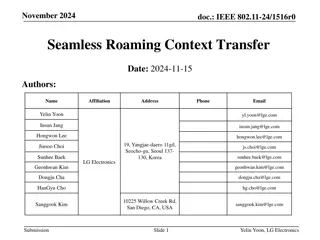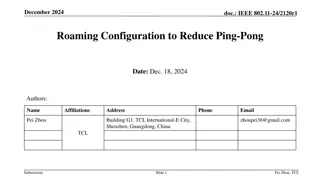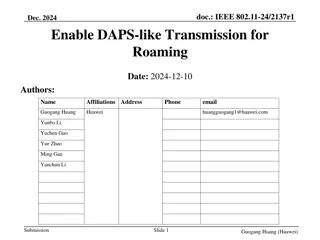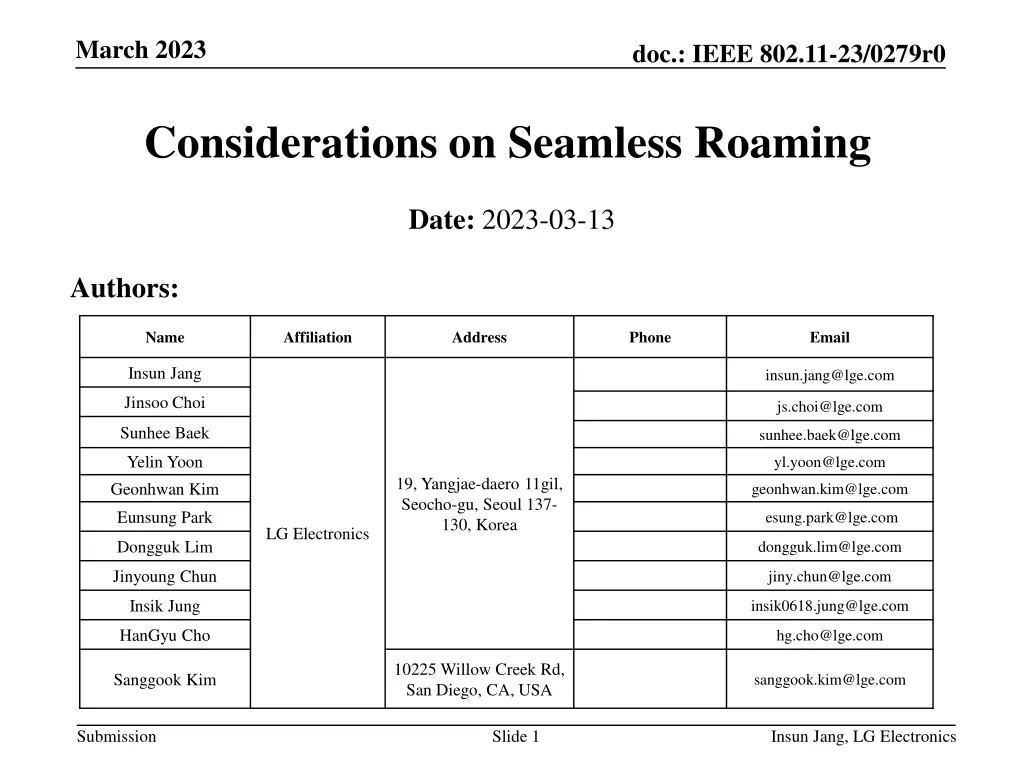
Considerations for Achieving Seamless Roaming in IEEE 802.11 Networks
Learn about the considerations and challenges in achieving seamless roaming in IEEE 802.11 networks, focusing on maintaining contexts/agreements and avoiding data interruption during roaming transitions. Discover potential solutions to reduce delay and enhance reliability for uninterrupted data exchange between access points and stations.
Download Presentation

Please find below an Image/Link to download the presentation.
The content on the website is provided AS IS for your information and personal use only. It may not be sold, licensed, or shared on other websites without obtaining consent from the author. If you encounter any issues during the download, it is possible that the publisher has removed the file from their server.
You are allowed to download the files provided on this website for personal or commercial use, subject to the condition that they are used lawfully. All files are the property of their respective owners.
The content on the website is provided AS IS for your information and personal use only. It may not be sold, licensed, or shared on other websites without obtaining consent from the author.
E N D
Presentation Transcript
March 2023 doc.: IEEE 802.11-23/0279r0 Considerations on Seamless Roaming Date: 2023-03-13 Authors: Name Affiliation Address Phone Email Insun Jang insun.jang@lge.com Jinsoo Choi js.choi@lge.com Sunhee Baek sunhee.baek@lge.com Yelin Yoon Geonhwan Kim yl.yoon@lge.com 19, Yangjae-daero 11gil, Seocho-gu, Seoul 137- 130, Korea geonhwan.kim@lge.com Eunsung Park esung.park@lge.com LG Electronics Dongguk Lim dongguk.lim@lge.com Jinyoung Chun jiny.chun@lge.com Insik Jung insik0618.jung@lge.com HanGyu Cho hg.cho@lge.com 10225 Willow Creek Rd, San Diego, CA, USA Sanggook Kim sanggook.kim@lge.com Submission Slide 1 Insun Jang, LG Electronics
March 2023 doc.: IEEE 802.11-23/0279r0 Introduction For a quite long time, we ve tried to solve issues of STAs moving from a BSS to another BSS E.g., using Fast Transition (FT) Protocol However, we are still experiencing the break to transmit/receive data during a roaming due to authentication and reassociation procedures (with additional delay) It is significantly important to avoid such interruption and delay as customers have always expected while the approved UHR PAR [1] has a scope of considering mobility between BSSs We need some mechanisms to achieve high reliability with reducing the delay Therefore, in this contribution, we share some considerations to achieve seamless roaming in UHR Especially, with the perspective of AP MLD domain [2] Submission Slide 2 Insun Jang, LG Electronics
March 2023 doc.: IEEE 802.11-23/0279r0 Overview of Current Roaming Non-AP MLD disassociates with the currently associated AP MLD (AP MLD 1) when intending to roam to another AP MLD (AP MLD 2) Non-AP MLD authenticates and reassociate with AP MLD 2 (e.g., over- the-air case in fast transition (FT)) After successful setup and authentication, the non-AP MLD negotiates some agreements with AP MLD 2 again (e.g., BA agreement) Submission Slide 3 Insun Jang, LG Electronics
March 2023 doc.: IEEE 802.11-23/0279r0 Potential Considerations Maintenance of Contexts/Agreements When authenticated and reassociated, necessary security keys (e.g., PTK) are established (e.g., /w.o 4-way handshake in FT) and some agreements (e.g., BA) are reset It leads to additional delay which prevents data frame exchange seamlessly We need method(s) where most or all of them can be maintained even during/after roaming Avoidance of data interruption Before data path to a new AP MLD, i.e., before creating the DS-to-STA mapping for the AP as a result of reassociation, the AP cannot transmit any Data frames (as Class 3 frame) to the roaming STA The AP wouldn t guarantee whether it can be transmitted to the STA (without capa. negotiation) We need method(s) to enable data frame exchanges during roaming by making data paths Submission Slide 4 Insun Jang, LG Electronics
March 2023 doc.: IEEE 802.11-23/0279r0 Potential Considerations (Cont d) Light Frame Exchange Current Authentication and Reassociation frames overhead are heavy to support seamless roaming We need light frames compared to existing ones where during their exchange, the new AP MLD and STAs can negotiate security key, capabilities, and operational parameters Submission Slide 5 Insun Jang, LG Electronics
March 2023 doc.: IEEE 802.11-23/0279r0 Observations on AP MLD from 11be As a good candidate to resolve those considerations, we can consider an architecture where APs (involved in roaming) are in an AP MLD [2], which can have the followings on some level MLD-level contexts/agreements (e.g., PTK, BA agreements) can be maintained MLD-level DS-to-STA mapping (i.e., data path) Usage of multi-link probe request/response to discover APs in the same AP MLD Additionally, to enable above-mentioned ones, we need mechanism(s) existing multi-link (ML) setup is reconfigured when roaming by involving the new AP(s) to be roamed without any tear-down (disassociation) We may reuse Reconfiguration Multi-link Element to change the link(s) for roaming Submission Slide 6 Insun Jang, LG Electronics
March 2023 doc.: IEEE 802.11-23/0279r0 AP MLD for Roaming APs in AP Group 1 and 2 are affiliated with the same AP MLD APs in the same group may be in a physical device (collocated) Roaming would be generally needed between groups We may allow for a non-AP MLD to be connected with APs in multiple groups (e.g., AP 2 and AP 4) Submission Slide 7 Insun Jang, LG Electronics
March 2023 doc.: IEEE 802.11-23/0279r0 Examples of Roaming Procedure Assuming ML setup reconfiguration can be performed without tear-down Non-AP MLD may change one or more link(s) at a time Non-AP MLD may add additional link(s) temporarily for a STA After roaming, the previous links will be deleted Submission Slide 8 Insun Jang, LG Electronics
March 2023 doc.: IEEE 802.11-23/0279r0 Further Considerations Identification of Group Each group may be identified necessarily due to lack of ID space The identification (if defined) would be utilized in discovery (e.g., multi-link probe request/response) and multi-link setup (e.g., reconfiguration) Upper (Common) MAC sublayers in AP MLD We can think about where upper MAC sublayer exists, e.g., per AP Group and/or across all of AP Groups (i.e., centralized) It can depend on which parameters, which is at MLD-level in 11be, should be at MLD- level across AP groups or AP Group-level (like MLD-level in 11be) At least, it would be better to have an Upper (Common) MAC sublayer across all of AP groups Submission Slide 9 Insun Jang, LG Electronics
March 2023 doc.: IEEE 802.11-23/0279r0 Conclusion In this contribution, we ve shared considerations to achieve seamless roaming in UHR in terms of Maintenance of Contexts/Agreements Avoidance of data interruption Light Frame Exchange To resolve those considerations, we provide some examples of roaming based on ML setup reconfiguration based on AP MLD domain as a good candidate feature for seamless roaming with further considerations Identification of Group Upper (Common) MAC sublayer in AP MLD Submission Slide 10 Insun Jang, LG Electronics
March 2023 doc.: IEEE 802.11-23/0279r0 References [1] 23/0480r0, UHR Proposed PAR [2] 23/1910r3, Seamless Roaming for UHR Submission Slide 11 Insun Jang, LG Electronics

